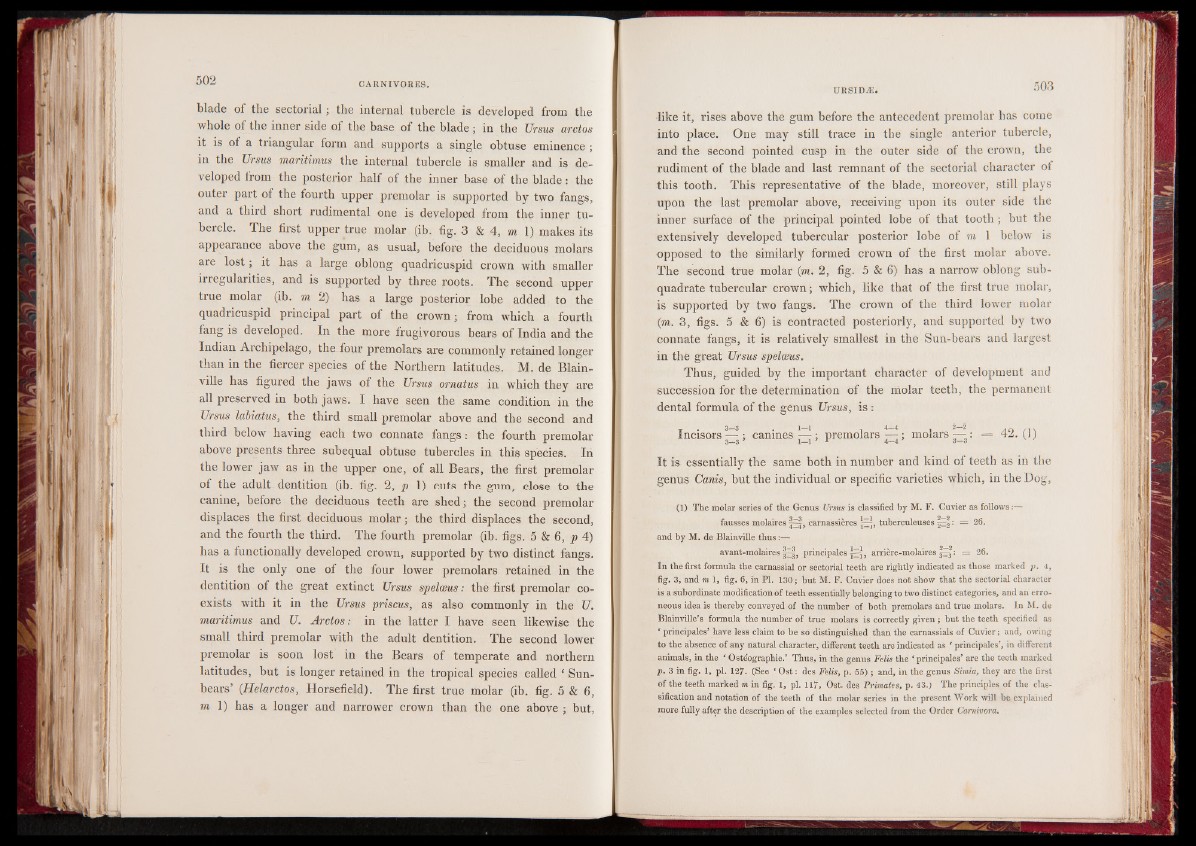
blade of the sectorial; the internal tubercle is developed from the
whole of the inner side of the base of the blade; in the Ursus arctos
it is of a triangular form and supports a single obtuse eminence ;
in the Ursus maritimus the internal tubercle is smaller and is developed
from the posterior half of the inner base of the blade: the
outer part of the fourth upper premolar is supported by two fangs,
and a third short rudimental one is developed from the inner tubercle.
The first upper true molar (ib. fig. 3 & 4, m 1) makes its
appearance above the gum, as usual, before the deciduous molars
are lost; it has a large oblong quadricuspid crown with smaller
irregularities, and is supported by three roots. The second upper
true molar (ib. m 2) has a large posterior lobe added to the
quadricuspid principal part of the crown; from which a fourth
fang is developed. In the more frugivorous bears of India and the
Indian Archipelago, the four premolars are commonly retained longer
than in the fiercer species of the Northern latitudes. M. de Blain-
ville has figured the jaws of the Ursus ornatus in which they are
all preserved in both jaws. I have seen the same condition in the
Ursus labiatus, the third small premolar above and the second and
third below having each two connate fangs: the fourth premolar
above presents three subequal obtuse tubercles in this species. In
the lower jaw as in the upper one, of all Bears, the first premolar
of the adult dentition (ib. fig. 2, p 1) cuts the gum, close to the
canine, before the deciduous teeth are shed; the second premolar
displaces the first deciduous molar; the third displaces the second,
and the fourth the third. The fourth premolar (ib. figs. 5 & 6, p 4)
has a functionally developed crown, supported by two distinct fangs.
It is the only one of the four lower premolars retained in the
dentition of the great extinct Ursus speloeus: the first premolar coexists
with it in the Ursus prisons, as also commonly in the U.
maritimus and U. Arctos: in the latter I have seen likewise the
small third premolar with the adult dentition. The second lower
premolar is soon lost in the Bears of temperate and northern
latitudes, but is longer retained in the tropical species called ‘ Sun-
bears’ (Helarctos, Horsefield). The first true molar (ib. fig. 5 & 6,
m 1) has a longer and narrower crown than the one above ; but,
like it, rises above the gum before the antecedent premolar has come
into place. One may still trace in the single anterior tubercle,
and the second pointed cusp in the outer side of the crown, the
rudiment of the blade and last remnant of the sectorial character of
this tooth. This representative of the blade, moreover, still plays
upon the last premolar above, receiving upon its outer side the
inner surface of the principal pointed lobe of that tooth; but the
extensively developed tubercular posterior lobe of m 1 below is
opposed to the similarly formed crown of the first molar above.
The second true molar (m. 2, fig. 5 & 6) has a narrow oblong subquadrate
tubercular crown; which, like that of the first true molar,
is supported by two fangs. The crown of the third lower molar
(m. 3, figs. 5 & 6) is contracted posteriorly, and supported by two
connate fangs, it is relatively smallest in the Sun-bears and largest
in the great Ursus speloeus.
Thus, guided by the important character of development and
succession for the determination of the molar teeth, the permanent
dental formula of the genus Ursus, is :
Incisors — ; canines— ; premolars molars — : = 42.(1) 3—3 ’ 1—1 ’ r 4—4 ’ 3—3
It is essentially the same both in number and kind of teeth as in the
genus Canis, but the individual or specific varieties which, in the Dog,
(1) The molar series of the Genus Ursus is classified by M. F. Cuvier as follows :—
fausses molaires carnassières tuberculeuses ezt : = 26.
and by M. de Blainville thus léfcivf
avant-molaires jH , principales jEj, arrière-molaires : = 26.
In the first formula the carnassial or sectorial teeth are rightly indicated as those marked p. 4,
fig. 3, and m 1, fig. 6, in PI. 130; but M. F. Cuvier does not show that the sectorial character
is a subordinate modification of teeth essentially belonging to two distinct categories, and an erroneous
idea is thereby conveyed of the number of both premolars and true molars. In M. de
Blainville’s formula the number of true molars is correctly given ; but the teeth specified as
S principales’ have less claim to be so distinguished than the carnassials of Cuvier ; and, owing
to the absence of any natural character, different teeth are indicated as ' principales’, in different
animals, in the ‘ Ostéographie.’ Thus, in the genus Felis the | principales’ are the teeth marked
p. 3 in fig. 1, pi. 127. (See ‘ Ost : des Felis, p. 55) ; and, in the genus Simla, they are the first
of the teeth marked m in fig. 1, pi. 117, Ost. des Primates, p. 43.) The principles of the classification
and notation of the teeth of the molar series in the present Work will be explained
more fully after the description of the examples selected from the Order Carnivora.